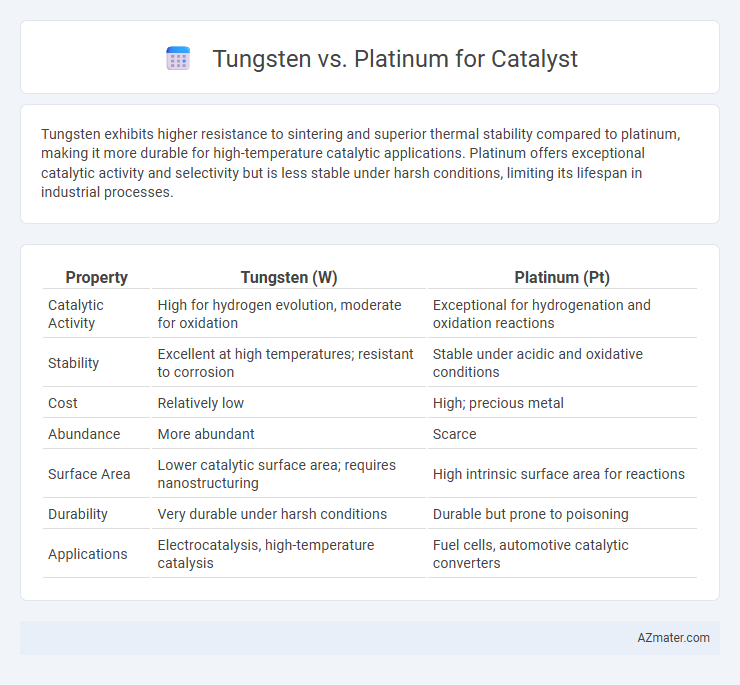Tungsten exhibits higher resistance to sintering and superior thermal stability compared to platinum, making it more durable for high-temperature catalytic applications. Platinum offers exceptional catalytic activity and selectivity but is less stable under harsh conditions, limiting its lifespan in industrial processes.
Table of Comparison
| Property | Tungsten (W) | Platinum (Pt) |
|---|---|---|
| Catalytic Activity | High for hydrogen evolution, moderate for oxidation | Exceptional for hydrogenation and oxidation reactions |
| Stability | Excellent at high temperatures; resistant to corrosion | Stable under acidic and oxidative conditions |
| Cost | Relatively low | High; precious metal |
| Abundance | More abundant | Scarce |
| Surface Area | Lower catalytic surface area; requires nanostructuring | High intrinsic surface area for reactions |
| Durability | Very durable under harsh conditions | Durable but prone to poisoning |
| Applications | Electrocatalysis, high-temperature catalysis | Fuel cells, automotive catalytic converters |
Introduction to Tungsten and Platinum Catalysts
Tungsten catalysts exhibit exceptional thermal stability and high resistance to sulfur poisoning, making them ideal for hydroprocessing and hydrogenation reactions in harsh industrial environments. Platinum catalysts are renowned for their superior catalytic activity and selectivity in oxidation, hydrogenation, and reforming processes, often employed in automotive catalytic converters and fine chemical synthesis. Both metals enable efficient reaction pathways, with tungsten favored for robustness and platinum preferred for high reactivity and precision in catalysis.
Chemical Properties Relevant to Catalysis
Tungsten exhibits high thermal stability and resistance to oxidation, making it a robust catalyst material in high-temperature reactions such as hydrocracking and ammonia synthesis. Platinum offers exceptional catalytic activity and selectivity due to its ability to adsorb and activate hydrogen molecules efficiently, widely used in fuel cells and hydrogenation processes. The difference in electronic configuration influences tungsten's carbide formation, enhancing durability, whereas platinum's noble metal characteristics provide superior resistance to poisoning and corrosion.
Catalytic Efficiency: Tungsten vs Platinum
Tungsten catalysts exhibit high thermal stability and strong resistance to sulfur poisoning, which enhances their catalytic efficiency in harsh reaction environments compared to platinum. Platinum catalysts offer superior activity and selectivity in hydrogenation and oxidation reactions, driven by their excellent electronic properties and surface adsorption capabilities. While platinum remains the benchmark for catalytic efficiency in many applications, tungsten's robustness and cost-effectiveness make it a competitive alternative in industrial catalysis.
Cost Comparison and Economic Viability
Tungsten catalysts typically offer a more cost-effective alternative to platinum due to their lower raw material and production expenses, making them attractive for large-scale industrial applications. Despite platinum's superior catalytic efficiency and durability in processes like hydrogenation, tungsten's affordability significantly enhances its economic viability in cost-sensitive environments. Evaluating total lifecycle costs, including performance longevity and replacement frequency, positions tungsten as a competitive solution in catalyst design where budget constraints are critical.
Durability and Stability in Reactions
Tungsten exhibits exceptional durability and stability in catalytic reactions due to its high melting point and resistance to corrosion, making it ideal for harsh reaction environments. Platinum, while highly effective as a catalyst with excellent activity and selectivity, tends to degrade faster under extreme conditions due to sintering and poisoning. Tungsten's robust structural integrity ensures longer catalyst lifespans, especially in high-temperature and acidic or oxidative settings, surpassing platinum's stability in similar applications.
Environmental Impact and Sustainability
Tungsten catalysts exhibit lower environmental toxicity and higher abundance compared to scarce and energy-intensive platinum, making tungsten a more sustainable option for large-scale applications. Tungsten's high thermal stability and recyclability reduce waste and energy consumption during catalyst regeneration processes, contributing to a smaller carbon footprint. While platinum offers superior catalytic efficiency in some reactions, tungsten's environmental benefits and cost-effectiveness drive increased adoption in green chemistry and sustainable industrial catalysis.
Applications in Industrial Processes
Tungsten catalysts excel in hydrocracking and desulfurization in petroleum refining due to their high thermal stability and resistance to poisoning. Platinum catalysts are widely used in automotive catalytic converters and industrial oxidation reactions, offering superior activity and selectivity in hydrogenation and reforming processes. The choice between tungsten and platinum depends on operating conditions and desired reaction specificity in industrial applications.
Availability and Global Supply Chains
Tungsten offers greater availability compared to platinum, with abundant reserves primarily in China, Vietnam, and Russia supporting a more stable global supply chain for catalyst manufacturing. Platinum, concentrated in South Africa and Russia, faces higher supply risks due to geopolitical tensions and limited mining locations. The tungsten supply chain benefits from diversified sources and lower price volatility, making it a more sustainable option for large-scale catalyst applications.
Recent Advances in Catalyst Research
Recent advances in catalyst research highlight tungsten's increased role as a cost-effective alternative to platinum due to its superior thermal stability and resistance to sulfur poisoning in catalytic converters. Tungsten-based catalysts, especially tungsten carbide and tungsten oxide composites, exhibit enhanced catalytic activity and durability in hydrogen evolution and oxygen reduction reactions, matching or surpassing platinum's performance under certain conditions. Ongoing studies emphasize tungsten's tunable electronic properties and synergistic effects with other transition metals, positioning it as a promising candidate for sustainable and efficient catalyst development.
Future Trends in Catalyst Development
Tungsten catalysts are gaining prominence due to their high thermal stability and cost-effectiveness compared to platinum, which remains favored for its unparalleled catalytic efficiency in automotive and chemical processes. Future trends highlight increasing research in tungsten-based bimetallic catalysts to enhance activity and durability while reducing reliance on scarce platinum. Advances in nanostructuring and support materials are expected to further improve tungsten catalysts' selectivity and resistance to poisoning, positioning tungsten as a sustainable alternative in next-generation catalytic applications.

Infographic: Tungsten vs Platinum for Catalyst
 azmater.com
azmater.com